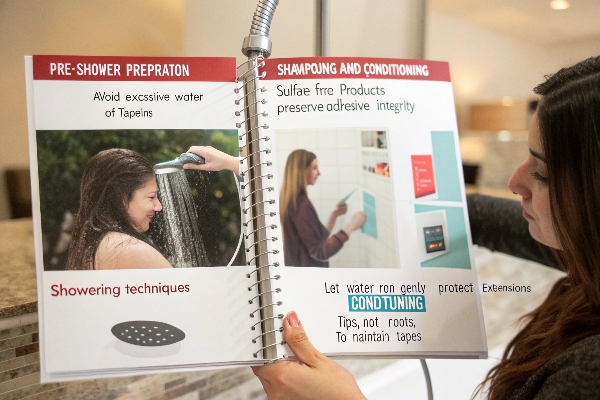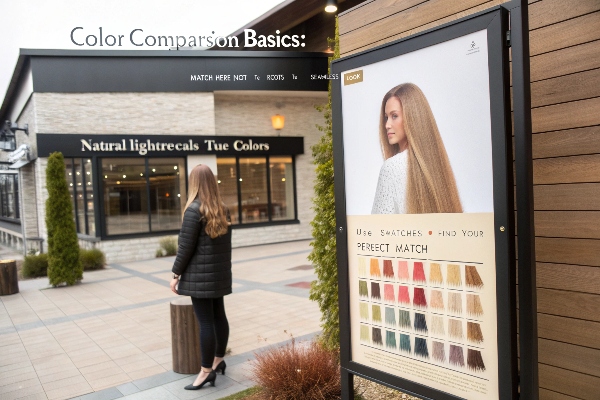When I first considered extensions, my main concern was how naturally they’d feel amidst my own hair. Here’s what I found.
Quality hair extensions made of human hair mimic the texture and movement of natural hair, becoming nearly indistinguishable when properly blended and maintained.
Blending techniques and proper application enhance their realism, making sure they feel and act like one’s natural hair with little perceptible difference.
How Uncomfortable Are Hair Extensions?
Comfort was crucial in my extension decision, so I explored potential discomfort. Here’s the general consensus.
Discomfort from hair extensions varies based on attachment type, with initial unfamiliarity subsiding once adjusted, though poor application or heavy tension can cause ongoing discomfort.
Equal weight distribution and correctly applied extensions improve comfort. Professionally installed extensions with monitored tension1 minimize risks, relieving excess pressure on natural roots.
How Long Does It Take for Extensions to Feel Normal?
Adapting to extensions was a concern for me, leading me to discover adjustment timelines. Here’s a general timeline.
Extensions typically feel normal within a few days to a week, as the scalp acclimates to the added weight and users adjust styling practices.

Routine practices, like washing and styling, quickly incorporate extensions, smoothing transition from weight awareness to near-forgotten presence amidst daily activities.
Do You Wash Your Hair Like Normal with Extensions?
Knowing whether I’d change my washing routine with extensions was critical. Here’s the routine adaptation needed.
Hair washing with extensions involves gentler techniques and specialized products, focusing on conditioning over roots to minimize product buildup on application points.
Mild shampoos and conditioners with sulfate-free formulas2 prevent extension drying3. Dividing hair when washing ensures coverage without disturbing bond sites, enhancing longevity.
What Are the Negatives of Hair Extensions?
Weighing pros and cons led me to consider extensions’ drawbacks. Here’s what emerged.
Negatives of hair extensions include potential strain on natural hair, increased maintenance needs, risk of scalp irritation, and financial costs from continual investment.

Extended reliance raises long-term hair health concerns, with potential follicle stress mandating professional oversight and cost management, balanced against aesthetic benefits.
Will I Regret Hair Extensions?
Concern about regrets prompted my research into long-term satisfaction. Here’s a cautionary look.
Regret from hair extensions often arises from improper application or unmet expectations, highlighting the importance of thorough research, quality selection, and realistic goal-setting.
Informed choices and professional consultation mitigate dissatisfaction, aligning expected outcomes with practical realities of maintenance, financial investment, and potential hair health.
How to Hide Extensions in Thin Hair?
Concealing extensions in fine hair was a challenge. Here’s how to achieve discreet integration.
Hiding extensions in thin hair involves strategic placement techniques, utilizing smaller wefts, and using texture-enhancing products to maintain discretion without visible sign of application.
Position extensions around thicker sections, avoiding part lines to conceal bond visibility. Volume-building products enhance thickness at roots, smoothly covering transition points.
Can I Wear My Hair Up with Extensions?
Versatile styling was essential for me, including updos. Here’s the possibility.
Wearing hair up with extensions is possible by strategically positioning extensions, covering bond areas, and tailoring styles to hide attachment points and ensure security.

Low ponytails, buns, and half-updos skillfully conceal extension tracks within style architecture, preserving confident volume and maintenance ease without compromise.
Is My Hair Actually Thinner After Extensions?
Concerns about hair thinning from extensions are valid. Here’s an examination of this risk.
Hair may appear thinner after extensions due to temporary shedding or stress-induced breakage at the root sites, alleviated by breaks between installation and correct usage.
Monitor usage frequency, ensuring professional oversight limits stress on follicles, preventing thinning perceptions or progressive damage through thoughtful extension choices.
Conclusion
Hair extensions offer significant aesthetic enhancement, though understanding application, potential impacts, and maintenance expectations ensures long-term satisfaction. Personal comfort, financial capabilities, and natural hair health must be balanced to achieve both visual goals and personal well-being.







